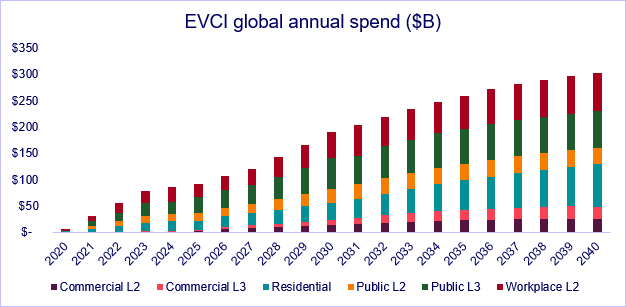EV charging ports are expected to grow globally at a 12.3% compound annual growth rate from 2026 through 2040, according to Wood Mackenzie’s infrastructure forecast report.
Wood Mackenzie said it expects 206.6 million charging ports to be deployed globally by 2040, reaching a market of $300 billion. Wood Mackenzie also said it expects the residential charging sector to remain the dominant sector, adding 133 million ports globally.

“As utilization in public charging increases and infrastructure efficiency improves, we expect the ratio of EVs to public chargers to increase from 7.5 battery electric vehicles per charger in 2025 to 14.2 in 2040,” said Oliver McHugh, senior EV charging research analyst for Wood Mackenzie.
Level-2 residential charging dominates the market, and Wood Mackenzie said it expects the segment to comprise approximately two out of every three charging ports worldwide through 2050.
“This segment’s sustained appeal stems from its ability to deliver the optimal balance of convenience, charging performance, and value that resonates most strongly with EV owners,” said Emil Koenig, senior research analyst, EV charging and power and renewables for Wood Mackenzie.
Despite challenges in the market, Wood Mackenzie expects the U.S. public charger segment to outpace global growth, increasing at a compound annual growth rate of 14% through 2040. The U.S. market is expected to reach 475,000 ports and generate $3.3 billion in annual market value by 2040.
(Read: “Strategies for charging EVs with solar, boosting demand for solar power”)
This content is protected by copyright and may not be reused. If you want to cooperate with us and would like to reuse some of our content, please contact: editors@pv-magazine.com.









By submitting this form you agree to pv magazine using your data for the purposes of publishing your comment.
Your personal data will only be disclosed or otherwise transmitted to third parties for the purposes of spam filtering or if this is necessary for technical maintenance of the website. Any other transfer to third parties will not take place unless this is justified on the basis of applicable data protection regulations or if pv magazine is legally obliged to do so.
You may revoke this consent at any time with effect for the future, in which case your personal data will be deleted immediately. Otherwise, your data will be deleted if pv magazine has processed your request or the purpose of data storage is fulfilled.
Further information on data privacy can be found in our Data Protection Policy.